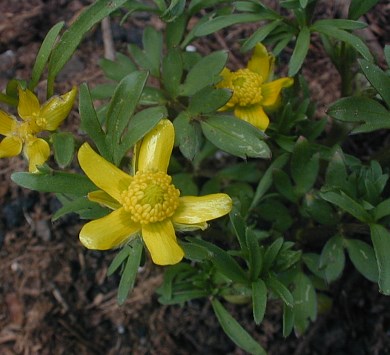Description: This perennial wildflower consists of a small tuft of basal leaves and flowering stalks; a tufted plant is typically about 6" tall and 6" across. The basal leaves are usually divided into 3-5 leaflets; these leaflets are divided into narrow lobes and they may have a few teeth along their margins. There is a variety of Early Buttercup (var. apricus) with basal leaves that are shallowly divided into wide lobes or teeth, but it is uncommon. Each basal leaf has a long slender petiole. The flowering stalks are light green to purplish brown; each stalk has 1-2 cauline leaves. The cauline leaves are smaller in size than the basal leaves; they are either sessile or short-stalked. The cauline leaves are undivided, or they have 2-3 small lobes. Both basal and cauline leaves are medium green and either glabrous or silky-hairy. Both the flowering stalks and the petioles of basal leaves are usually silky-hairy.

The flowers occur
individually or in small loose clusters. Each flower is about ¾–1"
across, consisting of 5 spreading petals (rarely more), 5 spreading
sepals, a ring of numerous stamens, and a dense cluster of pistils in
the center. The yellow petals are oblong or elliptic-oblong in shape;
they are longer than wide. The green or yellowish green sepals are
ovate in shape and usually hairy; they are shorter than the petals. The
blooming period occurs during mid-spring and lasts about 2-3 weeks.
Each flower is replaced by a dense cluster of beaked achenes spanning
about 1/3" across. These achenes are orbicular and flat-sided (about
2.5–3.0 mm. across); their beaks are straight or curved (about 1.5–2
mm. long), while their sides are smooth. The root system consists of a
tuft of thickened fibrous roots. This wildflower spreads by reseeding
itself.
Cultivation:
The preference is full sun to light shade, mesic to dry conditions, and
a rather poor soil containing rocky material or sand. This buttercup is
a candidate for rock gardens.
Range & Habitat:
Early Buttercup occurs occasionally throughout Illinois (see Distribution
Map), where it is native. Habitats include upland woodlands,
thinly wooded
bluffs, rocky savannas and sandy savannas, hill prairies, sand
prairies, rocky glades, and pastures. This wildflower is found in
rather dry areas where there is sparse ground vegetation.

Faunal
Associations:
The nectar and pollen of the flowers attract primarily bees and Syrphid
flies. Bee visitors of Early Buttercup's flowers include honeybees,
Little Carpenter bees (Ceratina spp.), Cuckoo bees (Nomada
spp.), Mason bees (Osmia spp.), Halictid
bees (Halictus spp., Lasioglossum spp.,
& others), and Andrenid bees (Andrena spp.).
Less common visitors of the flowers include butterflies, skippers, and
miscellaneous flies (other than Syrphid). The seeds and foliage of Ranunculus
spp. (buttercups) are eaten to a limited extent by the Wild
Turkey, Ruffed Grouse, and Ring-Necked Pheasant. The seeds are also
eaten to a limited extent by the Eastern Chipmunk, Gray Squirrel, Fox
Squirrel, and voles. During the winter, Snow Buntings feed on the seeds
of some buttercup species in fields and pastures. Because of the toxic
foliage, Early Buttercup and other buttercups are often rejected by
cattle and other mammalian herbivores as a source of food.
Photographic Location:
The wildflower garden of the webmaster in Urbana, Illinois.
Comments:
This buttercup is the earliest to bloom. Among the many Ranunculus
spp. (buttercups) in Illinois, Early Buttercup can be
distinguished by its diminutive size, relatively large flowers (at
least ¾" across), and deeply lobed leaves (except for var.
apricus). Both the blades of the basal leaves and the petals
of the flowers are longer than they are wide; other buttercups often
have leaf blades and flower petals that are about as wide as they are
long. Mature specimens of Early Buttercup produce fibrous roots that
are slightly swollen and fleshy, although not truly tuberous.